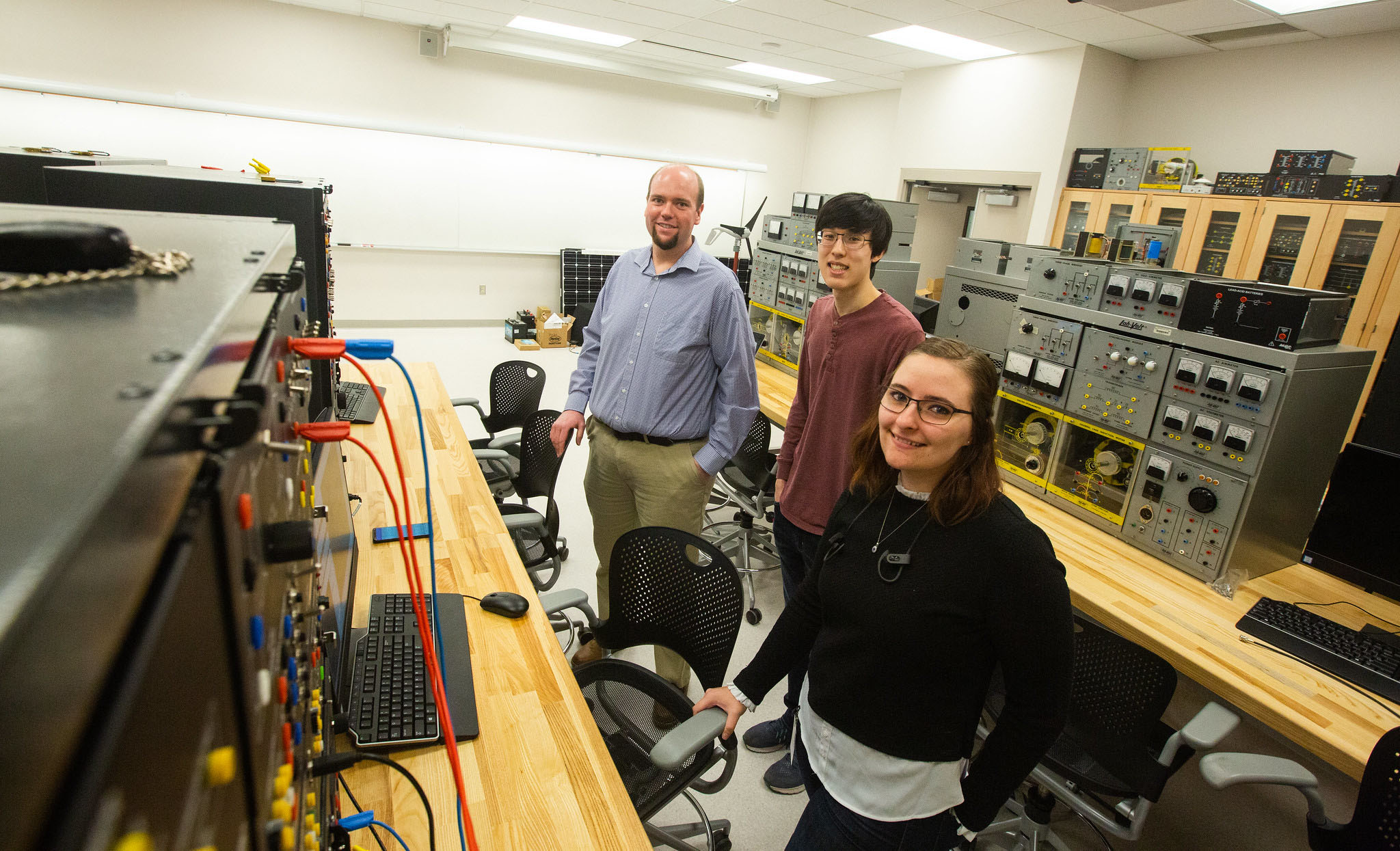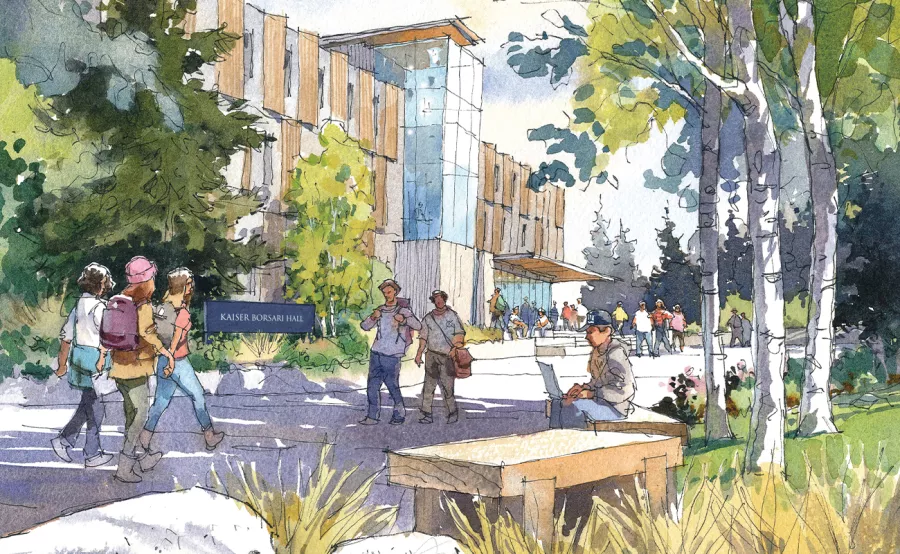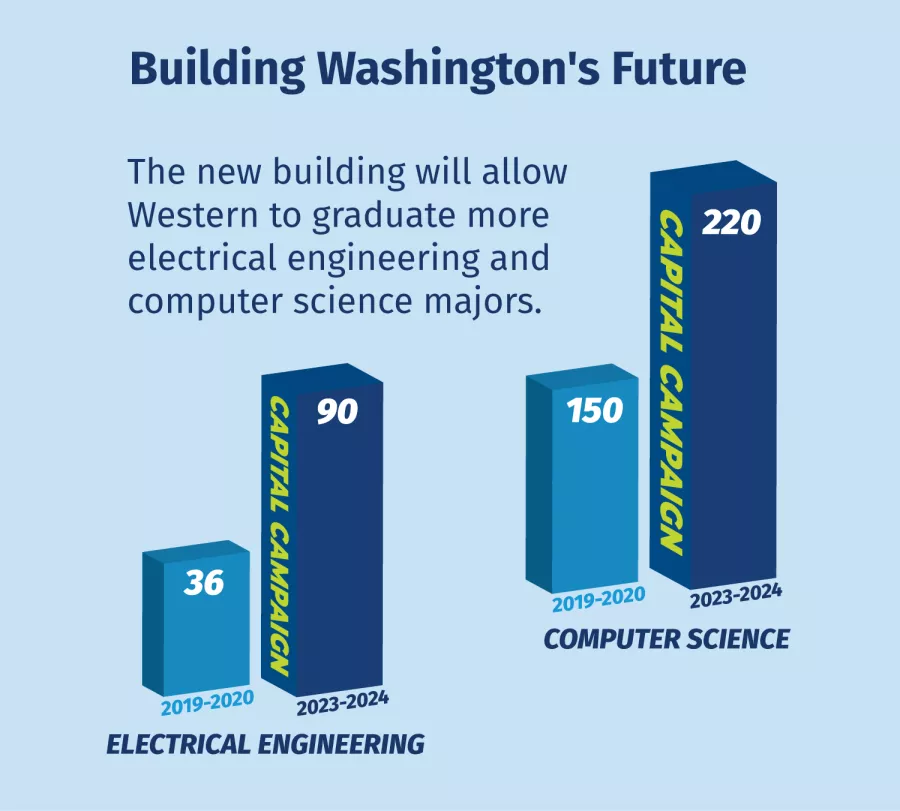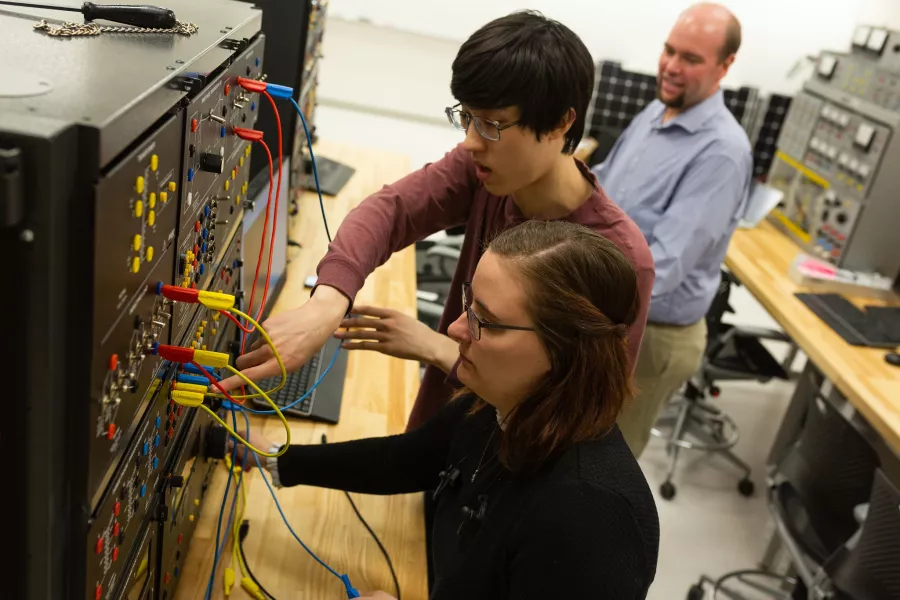Despite rapid technological advancements, the decades ahead pose formidable challenges. The scale and magnitude of pandemics, climate change, and other grand challenges require us to develop bold new ways of thinking, creative partnerships, and state-of-the-art research.
Most importantly, these challenges require a commitment to the next generation of problem-solvers.
To prepare this next wave of innovators, Western Washington University is embarking on a bold vision to expand and transform technical education – a vision that will include an additional 94 workforce-ready electrical engineering and computer science graduates each year, and a new building to house Western’s burgeoning electrical engineering, computer science, and energy science programs.
The new building, planned for completion in 2024, will create more space for interdisciplinary collaboration and experiential projects in partnership with industry, allowing students to solve real-world problems. The expansion of the programs housed within the space will also help feed the nation’s growing demand for employees educated in science, technology, engineering, and mathematics (STEM) fields.
Through the Building Washington’s Future campaign, the Western Foundation is raising $20 million for the project. Fueled by the urgency of preparing graduates with the training necessary to meet our grand challenges, the year-long campaign is one of the most important fundraising initiatives the WWU Foundation has undertaken, and the first capital campaign to raise funds for academic space. The need for highly trained graduates is particularly acute in Washington.
“Washington is among the top five states in technology sector job growth,” says Brad Johnson, dean of the College of Science and Engineering, “but we don’t produce nearly enough graduates.”
Workforce demand for undergraduate and graduate engineering and computer science students is estimated to be more than 23,000 annually in Washington state alone. Between 1990 and 2016, employment in STEM occupations grew 79 percent (from 9.7 million to 17.3 million) nationwide, and technology jobs saw a staggering 338 percent increase according to a 2018 report by the Pew Research Center.
Despite these workforce shortages, Western is turning away promising electrical engineering students because of insufficient space. In addition, underrepresented students confront disproportionately high barriers when studying STEM subjects and may more often encounter environments that are less welcoming, or in which they don’t see themselves.
Institutions such as Western have the opportunity to create a structure and culture that promotes engagement, connectedness, and persistence among students by positioning STEM as a context for growth and development. Institutions can also draw upon the cultural strengths that underrepresented students bring to the learning environment, using this information to improve curricular practices and programs.
Western’s expansion will also allow for an increase in diversity, equity, and inclusiveness through changes to the curriculum, classroom design, and recruitment. “We are developing a new program for first-year students that integrates non-traditional teaching methods,” Johnson says.
“Classrooms will be re-engineered to include more user-friendly features, and we will offer a greater number of opportunities for collaborative, project-based learning in groups. With more seats, the college will also be able to recruit more broadly.”
Western’s Institute for Energy Studies is also growing rapidly with an especially high demand for the new Energy Science and Technology degree, an interdisciplinary combination of applied science and technology, energy policy, and business practices. WWU’s energy degree programs have produced a total of 115 graduates, many of whom are filling gaps in the clean energy, efficiency, and utility sectors.
One of the first graduates from the program now leads energy strategy for Sales Force—a position the company only recently created. Many companies now recognize that energy strategy is directly linked to their bottom line.
“Western Washington is the vanguard of a new type of educational paradigm,” says Warren Michelsen, vice president and regional general manager for Trane and a founding member of Western’s Institute for Energy Studies Board. “There is a culture of creativity and thinking outside of the box. When you provide students who are empowered to think freely and take risks with a solid grounding in STEM subjects, you have the makings of a person who will be unstoppable in the workplace.”
The new $68 million building destined to bring all of these innovative programs together will be named for the founders of Alpha Technologies, Fred Kaiser and Grace Borsari, who provided a lead gift of $10 million to the Western Washington University Foundation’s $20 million capital campaign. The Washington State Legislature allocated $2 million for design-related expenses in 2019 and has signaled their intent to allocate $46 million for construction in the 2021-2023 capital budget for Western.
“We are leveraging state tax dollars to attract private industry partners so that we can work together to address problems,” says College of Science and Engineering’s Johnson.
Johnson hopes to attract more industry partners who can help develop programs as the college outlines its 10-year plan and defines its strategic vision in preparing students for a dynamic workforce. “Our partners want to see an increase in the talent pipeline,” Johnson says, “and we want to equip students with the skills to solve the sorts of problems they will encounter in the workplace.”
The college already collaborates with industry to provide several types of project-based learning opportunities.
“Many of our industry partners need devices and embedded systems that increase efficiencies and enable different systems to interface,” says John Lund, an associate professor in the College of Science and Engineering who advises students in the electrical engineering program. “This type of project helps students learn about the company while actively solving a real-world problem, which is something they can be really proud of. They also gain experience working in industry before they leave our doors.”
One of Lund’s most recent students, Riley Hernandez, ’20, B.S., mathematics and electrical engineering, developed her senior capstone project with an idea from Bellevue-based PACCAR, a major employer of Western graduates and a global leader in the design and manufacturing of commercial trucks.
Hernandez, a California native and the daughter of a trucking company entrepreneur, built a universal battery converter that transfers power between batteries, ensuring there is always enough power. “The device will also convert DC voltage to AC voltage,” Hernandez says. “It’s portable, so the driver could have it on hand to use as needed, or it could also sit in the engine and be a part of the system.”
Her project could help PACCAR ensure their trucks have sufficient battery power in the cab for ample heat, air conditioning, and lighting during overnight stops. “I’m trying to combine all of these systems in a cost-efficient way, and that’s what makes this unique,” says Hernandez, who hopes to work as an engineering consultant.
She is also eager for the expansion of the engineering program and excited about what it will mean for Western students of the future.
“I’m very excited about the new lab spaces,” Hernandez says. “There are not enough computers and instruments right now
because of space constraints. We have to rotate among labs to get space, and that can be hard.”
Hernandez’s classmate Daniel Guilder, ’20, B.S., electrical engineering also worked on a senior capstone project inspired by PACCAR, developing a device that automates truck battery readings such as voltage, temperature, and state of charge.
“My device is a bridge between the battery and the vehicle, providing automated readings for the driver. So, if drivers who sleep in their trucks want to access battery data, they will know how much power is available for the overnight use of systems such as heaters,” says Guilder, who hails from Puyallup.
Guilder worked on the project with his PACCAR-based adviser. His work was also guided by faculty advisors like Lund who provided regular feedback, and by his fellow students who were working on projects of their own. It was the opportunity for personal guidance and support, along with hands-on projects like this, that drew Guilder to Western.
“It’s a great feeling to develop a tangible item with a clear purpose and use for the company,” he says.
There are also tangible benefits for PACCAR and other industry partners.
“We have found that when you get companies that are actually invested (in student projects), they are much more deeply engaged; and, they may invest in a series of projects that lead to problem-solving on a larger scale,”says Johnson, who for many years led Western’s Advanced Materials Science and Engineering Center, which collaborates with several materials technology companies in the region.
Students like Hernandez and Guilder, whose STEM education is coupled with a strong liberal arts foundation in communication and critical-thinking, are being called upon as never before to provide their expertise in the workforce. The next generation of innovators and problem-solvers will come from universities able to provide a solid, comprehensive education in STEM fields with opportunities for experiential learning.
“Companies need well-rounded talent,” says Trane’s Michelsen. “What sets Western apart is students with better writing, critical thinking, and team skills. These give our alumni a leg up, preparing them for a graduate education and supporting them in their career evolution.”
On a broader scale, solutions to many of our grand challenges—including climate change—will emerge only through education and collaboration across disciplines, institutions, boundaries, and borders.



